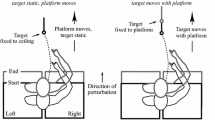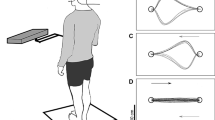Abstract.
The aim of the present study was to investigate the relationship between the focal and postural components of a functional movement during the preparatory phase of a task. The contribution of the arms, trunk, and legs were varied by having subjects reach for two targets within and two beyond arm's length. In addition, the degree of postural stability was manipulated by varying the size of the base of support (BoS). Nine subjects reached and grasped a dowel placed at four locations while standing on a force plate with their feet in a parallel or step stance (right foot forward) under simple reaction-time (RT) conditions. Anticipatory postural adjustments (APAs) occurring prior to arm movement and RTs were analyzed. APAs varied depending on the demands of the task. For movements within arm's length, subjects selected different strategies to initiate the movement. However, for movements beyond arm's length, all subjects used the same strategy: the center of pressure (CoP) was shifted posteriorly, which resulted in the center of mass (CoM) moving towards the target. Target distance and BoS had no effect on the onset of APAs. In contrast, amplitude and duration of APAs increased linearly with target distance, and amplitude was always greater during the more posturally stable BoS configuration. Although wrist RT increased linearly with movement amplitude for both stance configurations, the rate of change was less under the more stable BoS. These results suggest that, during the performance of a functional task, dynamic changes that occur in the trunk and lower extremities prior to initiation of arm movement serve not only to stabilize the body, but are also used to initiate and assist whole-body reaching.
Similar content being viewed by others
Author information
Authors and Affiliations
Additional information
Electronic Publication
Rights and permissions
About this article
Cite this article
Kaminski, T., Simpkins, S. The effects of stance configuration and target distance on reaching. Exp Brain Res 136, 439–446 (2001). https://doi.org/10.1007/s002210000604
Received:
Accepted:
Issue Date:
DOI: https://doi.org/10.1007/s002210000604




